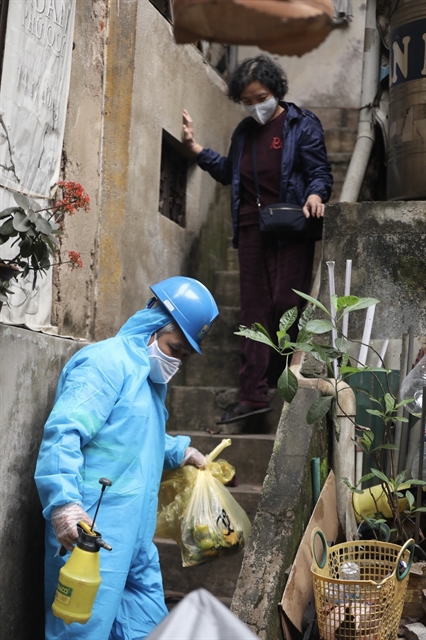 Society
Society

COVID patients treated at home are being urged to be careful with their waste disposal to limit the risk of spreading the virus..

|
| A medical worker collects waste from the home of COVID-19 self monitoring patients in Cửa Đông Ward, Hoàn Kiếm District, Hà Nội.— VNA/VNS Photo Minh Quyết |
HẢ NÔI - COVID patients treated at home are being urged to be careful with their waste disposal to limit the risk of spreading the virus.
As cases continue to rise in the capital city, adding pressure to already stretched medical facilities and health workers, people self-monitoring at home can do their bit.
Back in January, Hà Nội’s People’s Committee has issued instructions on classifying, collecting and transporting COVID-19 patients' waste at both medical facilities and at home.
But some patients say they are still in the dark about the best measures to dispose of household waste.
V.Q.T, a resident living in Bạch Mai Ward, Hai Bà Trưng District, said his wife and mother both tested positive for COVID-19 and were being treated at home.
But he said he had not received instructions on how to deal with waste and still disposed of it as he would normally do in the past.
N.T.T, a resident living in Nghĩa Đô Ward, Cầu Giấy District said she and her son both tested positive on Tuesday.
After making online health declarations with the ward’s medical station, she did not receive any instructions on how to deal with COVID-19 patients' waste.
Currently, she put the waste into separated nylon bags, tied tightly and then her relatives would bring the waste to the waste collection point as usual, she said.
Nguyễn Trọng Đông, deputy chairman of the capital’s People’s Committee said the purpose of carefully disposing of waste was to ensure that pathogens would not spread during collection, transportation and treatment.
It also ensured the safety of medical staff and people involved in waste management, especially when the volume of waste had been increasing due to the complex developments of the pandemic, he said.
The committee had told the city’s Information and Communications department to work with districts’ authority to strengthen dissemination so that local people know the process of classifying and collecting COVID-19 patients' waste to minimise the spread of the virus into the community, he added.
The instruction says all waste generated by COVID-19 self-monitoring patients is classified as infectious waste and will be collected into a yellow nylon bag, which is tightly tied and then be placed in the second yellow nylon bag, also tightly sealed. The yellow bags must be labelled “Waste potentially infected with SARS-CoV-2”.
After that, the waste will be disinfected and transported by local sanitation workers to points designated to store infectious waste at medical stations of communes, wards or towns or mobile medical stations or temporary storages assigned by local authorities.
The transport of the waste from the COVID-19 self-monitoring patients' house is carried out by the environmental sanitation unit in the area in collaboration with the community-based COVID-19 prevention team in the commune or ward.
The vehicles transporting the waste must guarantee not to drop or allow the waste to leak. It is transported to storage areas at medical stations of communes, wards or towns or mobile medical stations or temporary storages assigned by local authorities.
Data from the Ministry of Health shows that Hà Nội has topped its daily record for recent weeks. On Thursday, the capital again topped its daily record with 18,661 transmissions, and 20 deaths.
A report of the city’s Health Department said that by the end of Thursday, the number of COVID-19 patients that have been treated in the city was over 641,242, including more than 634,109 COVID-19 self-monitoring patients. — VNS




